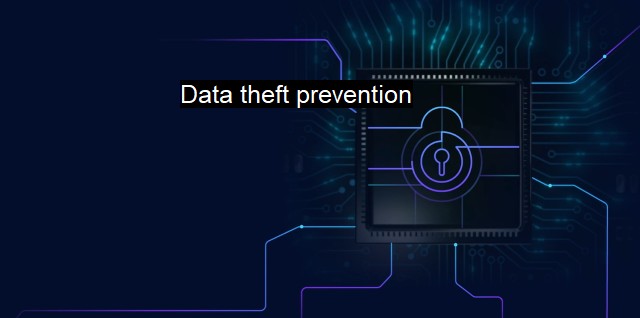What is Data theft prevention?
Mitigating the Risks of Cyber Attacks: The Critical Role of Data Theft Prevention Strategies and Tools
Data Theft Prevention refers to the policies, procedures, and tools employed to protect digital information from unauthorized access, alteration, or transmission. This form of information theft can include any scenario where an unauthorized individual wrongfully obtains data and aims to use it for malicious purposes such as fraud, deception, or ill-intended manipulation.Data Theft Prevention becomes utterly significant due to the increase of our reliance on digital data. Every single action performed online leaves a digital trace. Our bank accounts, personal information, professional data, and even recreational activities are all online, making them potential targets for cyber criminals. Hence, safeguarding such precious personal and financial data possesses critical importance.
Cybersecurity encompasses different measures, from installing robust antivirus systems to encrypting sensitive data and monitoring internet traffic for anomalies. Businesses guard their databases from intruders, not just to protect their proprietary information, but also to ensure they are complying with laws surrounding the safeguarding of personal data.
Anti-virus software forms a key line of defense in preventing data theft. It hunts for malicious software, known as malware which includes viruses, worms, trojan horses, ransomware, spyware, adware, etc. These pieces of software often aim to disrupt or damage computer operations, gather sensitive information, or gain unauthorized access to computer systems. Therefore, having a robust antivirus solution not only detects and removes these threats but also keeps the system functioning optimally.
The next line of defense is employing protective protocols such as Two-Factor Authentication (2FA). This adds an extra layer of security by requiring a second form of identification beyond just a password. Firewall configurations are also an effective method to protect networks from unauthorized and potentially harmful traffic.
The use of smart passwords and regular password change policies deter a lot of low-level data thieves from getting easy access. Many services now include a password strength meter which prevents users from picking weak options that are easily guessed. implementing a Virtual Private Network (VPN) can also curb the likelihood of data theft by providing a safe and encrypted channel for data to travel.
Education about safe online practices is another critical factor in Data Theft Prevention. Many breaches and data theft incidents occur because of human error: opening a phishing email, clicking on a malicious ad, or downloading an unsafe attachment. Cybersecurity training programs are therefore an essential tool in building an individual's capability in preventing data breaches.
Regular audits of IT assets and penetration testing (also called ethical hacking) help pinpoint potential vulnerabilities in a system right before a serious data breach happens. A well-maintained and updated system layered with continuous vulnerability patching builds a strong defense against the continuous threats of data theft.
Emphasizing real-time monitoring and analytics, organizations can identify processes or activities that drag information outside the defined safety barriers. This enables them to diagnose threats before they can cause any significant harm. For this, many companies employ Security Information and Event Management (SIEM) systems to collate and analyze real-time data from across their networks.
The adoption of ‘Zero Trust’ security policies, where no person, device, or process is inherently trusted without adequate verification, boosts an organization’s security against data theft. These steps come together to create a risk management approach that is preventative rather than reactive.
Data Theft Prevention deals with an array of strategies and measures to protect data from cyber threats. Whether personal or business-related, diligent data protection provides us with peace in this era of global digitalization. Cybersecurity is not just about technology but rather a mix of people, processes, and technology coming together to counter the omnipresent threat of data theft. By being proactive about data theft prevention, everyone can contribute to the grander goal of securing our digital lives.

Data theft prevention FAQs
What is data theft prevention?
Data theft prevention refers to the measures taken to protect sensitive data from unauthorized access or theft. This includes implementing cybersecurity solutions such as anti-virus software, firewalls, and intrusion detection systems to safeguard data from cybercriminals.Why is data theft prevention important?
Data theft can cause significant financial and reputational damage to individuals and organizations. Without proper data theft prevention measures in place, sensitive data such as financial information, personal identity data, and trade secrets could be stolen and used for fraudulent activities.What are some common data theft prevention techniques?
Common data theft prevention techniques include strong password policies, data encryption, regular software updates, employee training on cybersecurity best practices, limiting access to sensitive data, and implementing robust cybersecurity solutions such as anti-virus and firewalls.What should businesses do to prevent data theft?
Businesses should conduct regular risk assessments to identify potential vulnerabilities in their systems and networks. They should also implement data theft prevention measures such as firewalls, intrusion detection systems, and anti-virus software. Additionally, they should provide ongoing employee training on cybersecurity best practices and limit access to sensitive data only to authorized personnel.| | A | | | B | | | C | | | D | | | E | | | F | | | G | | | H | | | I | | | J | | | K | | | L | | | M | |
| | N | | | O | | | P | | | Q | | | R | | | S | | | T | | | U | | | V | | | W | | | X | | | Y | | | Z | |
| | 1 | | | 2 | | | 3 | | | 4 | | | 7 | | | 8 | | |||||||